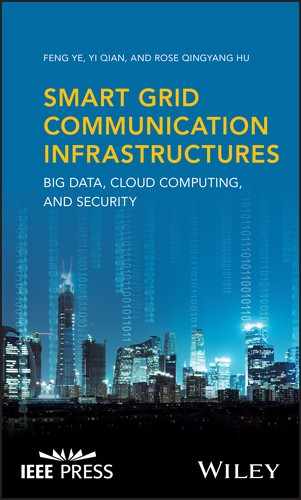13
Open Issues and Possible Future Research Directions
There are still several challenges and issues to be addressed in the smart grid communications infrastructure. In this chapter, we will present some of the open issues and point out possible directions for future research.
13.1 Efficient and Secure Cloud Services and Big Data Analytics
In the proposed information communications technology (ICT) framework, cloud services and big data analytics will be critical components of the smart grid communication infrastructure. Considering the amount of data and the scale of the grid, ways to achieve efficient and cost‐effective cloud services have yet to be studied. The exact techniques of big data analytics also need to be developed specifically for metering data as well as useful data from external sources. With those techniques, accurate price and energy forecasts can be made to enhance demand response and the operational efficiency of the grid as well. Besides efficiency, security is an equally important issue to be considered when developing cloud services and techniques for big data analytics so that the privacy of customers can be protected.
13.2 Quality‐of‐Service Framework
The quality‐of‐service (QoS) in the smart grid can be defined by the accuracy and effectiveness with which different pieces of information (such as the state of equipment, load information, and power pricing) are delivered in a timely manner to the respective parties. The QoS framework can be developed by identifying the specific QoS requirements and priorities for specific communication networks in the smart grid. For example, consider the latency requirements listed in Table 13.1.
Table 13.1 Latency requirements in smart grid communications.
| Maximum latency | Communication type |
| Protective relaying | |
| Sub‐seconds | Wide area situational awareness monitoring |
| Seconds | Substation and feeder supervisory control and data acquisition (SCADA) |
| Minutes | Monitoring noncritical equipment and marketing pricing information |
| Hours | Meter reading and longer‐term pricing information |
| Days/Weeks/Months | Collecting long‐term usage data |
13.3 Optimal Network Design
The smart grid will be deployed on a large scale with an increasing number of customers included. More data will be gathered and transmitted more frequently. For example, current metering data is gathered once in 15 minutes; however, a higher gathering frequency is needed for real‐time demand response. Therefore, the communication networks in smart grid will need to be enhanced to achieve better network performance that will meet the increasing demand for transmission of data. Technologies in smart grid communications are not separated from other communications. Many cutting‐edge technologies can be developed and deployed in the smart grid network design as well. For example, relaying, cooperative communications and small cells are being developed in the next generation of mobile communications networks can also be deployed for networks in the smart grid, especially home‐area networks, neighborhood‐area networks, and wide‐area monitoring systems. Those technologies will result in more efficient networks with larger coverage that are an important part of smart grid communications.
13.4 Better Involvement of Green Energy
Green energy or renewable resources have attracted a lot of attention recently. Several photovoltaic (PV) farms and wind farms have been deployed all over the world. However, the deployment, operational, and maintenance costs are still high compared with fossil‐fuel power stations. In the smart grid, a higher proportion of green energy is vital for lower greenhouse gas emissions. Research focusing on better involvement of green energy needs to be addressed. Some topics that need to be studied in the near future include management of renewable resources, deployment and management of energy storage units, and the involvement of microgrids.
13.5 Need for Secure Communication Network Infrastructure
If the smart grid is attacked, hackers can penetrate the network and alter critical system parameters, which could destabilize the grid unpredictably and cause a nationwide crisis. Security must be designed for various smart grid systems to meet their different requirements. Research directions include intrusion detection system (IDS) and intrusion prevention system (IPS) for smart communications infrastructure, for example, AMI and WAMS. IDS and IPS are particularly important in the area of big data analytics. Key management (e.g. public‐key infrastructure) should be studied as the smart grid evolves to secure not only new, and modern equipment but also legacy devices.
13.6 Electrical Vehicles
Electrical vehicles (EVs) and plug‐in hybrid electric vehicles (PHEVs) will consume a large portion of electricity in the near future. Several issues are raised because of EVs and PHEVs. For instance, what is the best way to manage the charging and discharging of those EVs and PHEVs so that demand response can still remain optimal for smoothing the power load? More power plants may be needed to compensate for the extra electricity requirements from EVs/PHEVs. However, that may not necessarily be the case, because EVs/PHEVs can also be power suppliers for the power grid. Together, EVs/PHEVs store a considerable amount of electricity. Unfortunately, utilizing such storage efficiently with proper controls still remains an open issue, because EVs/PHEVs are not regular appliances that remain in one place. Moreover, data collection and exchange will most likely go through wireless networks, and EVs/PHEVs tend to stay still for a relatively long period of time when charging and discharging. That raises the issue of security. How can the privacy of users of EVs/PHEVs be protected when exchanging useful information? Those issues need to be addressed before the roads are crowded with EVs/PHEVs in the near future.
